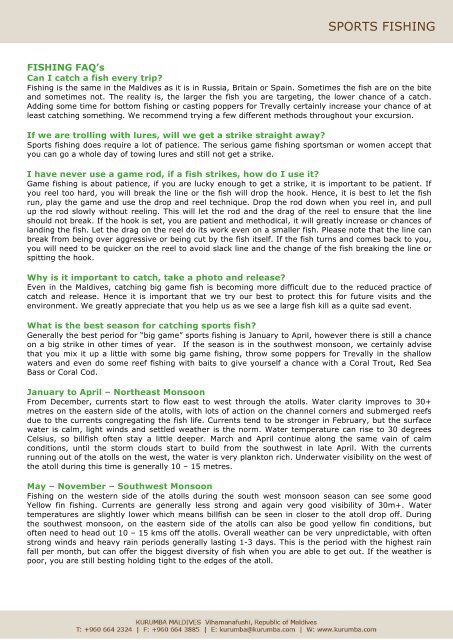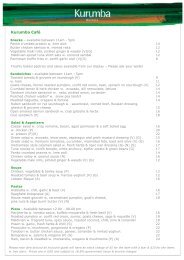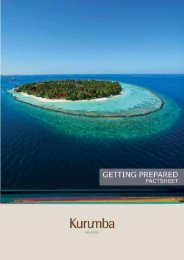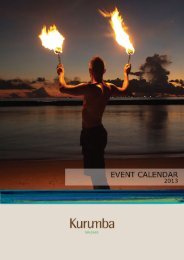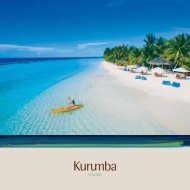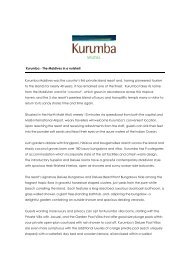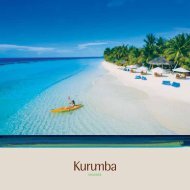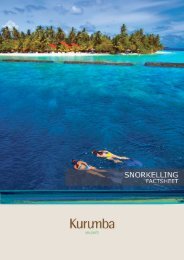Sports Fishing factsheet - Kurumba Maldives
Sports Fishing factsheet - Kurumba Maldives
Sports Fishing factsheet - Kurumba Maldives
Create successful ePaper yourself
Turn your PDF publications into a flip-book with our unique Google optimized e-Paper software.
!<br />
SPORTS FISHING<br />
FISHING FAQ’s<br />
Can I catch a fish every trip?<br />
<strong>Fishing</strong> is the same in the <strong>Maldives</strong> as it is in Russia, Britain or Spain. Sometimes the fish are on the bite<br />
and sometimes not. The reality is, the larger the fish you are targeting, the lower chance of a catch.<br />
Adding some time for bottom fishing or casting poppers for Trevally certainly increase your chance of at<br />
least catching something. We recommend trying a few different methods throughout your excursion.<br />
If we are trolling with lures, will we get a strike straight away?<br />
<strong>Sports</strong> fishing does require a lot of patience. The serious game fishing sportsman or women accept that<br />
you can go a whole day of towing lures and still not get a strike.<br />
I have never use a game rod, if a fish strikes, how do I use it?<br />
Game fishing is about patience, if you are lucky enough to get a strike, it is important to be patient. If<br />
you reel too hard, you will break the line or the fish will drop the hook. Hence, it is best to let the fish<br />
run, play the game and use the drop and reel technique. Drop the rod down when you reel in, and pull<br />
up the rod slowly without reeling. This will let the rod and the drag of the reel to ensure that the line<br />
should not break. If the hook is set, you are patient and methodical, it will greatly increase or chances of<br />
landing the fish. Let the drag on the reel do its work even on a smaller fish. Please note that the line can<br />
break from being over aggressive or being cut by the fish itself. If the fish turns and comes back to you,<br />
you will need to be quicker on the reel to avoid slack line and the change of the fish breaking the line or<br />
spitting the hook.<br />
Why is it important to catch, take a photo and release?<br />
Even in the <strong>Maldives</strong>, catching big game fish is becoming more difficult due to the reduced practice of<br />
catch and release. Hence it is important that we try our best to protect this for future visits and the<br />
environment. We greatly appreciate that you help us as we see a large fish kill as a quite sad event.<br />
What is the best season for catching sports fish?<br />
Generally the best period for “big game” sports fishing is January to April, however there is still a chance<br />
on a big strike in other times of year. If the season is in the southwest monsoon, we certainly advise<br />
that you mix it up a little with some big game fishing, throw some poppers for Trevally in the shallow<br />
waters and even do some reef fishing with baits to give yourself a chance with a Coral Trout, Red Sea<br />
Bass or Coral Cod.<br />
January to April – Northeast Monsoon<br />
From December, currents start to flow east to west through the atolls. Water clarity improves to 30+<br />
metres on the eastern side of the atolls, with lots of action on the channel corners and submerged reefs<br />
due to the currents congregating the fish life. Currents tend to be stronger in February, but the surface<br />
water is calm, light winds and settled weather is the norm. Water temperature can rise to 30 degrees<br />
Celsius, so billfish often stay a little deeper. March and April continue along the same vain of calm<br />
conditions, until the storm clouds start to build from the southwest in late April. With the currents<br />
running out of the atolls on the west, the water is very plankton rich. Underwater visibility on the west of<br />
the atoll during this time is generally 10 – 15 metres.<br />
May – November – Southwest Monsoon<br />
<strong>Fishing</strong> on the western side of the atolls during the south west monsoon season can see some good<br />
Yellow fin fishing. Currents are generally less strong and again very good visibility of 30m+. Water<br />
temperatures are slightly lower which means billfish can be seen in closer to the atoll drop off. During<br />
the southwest monsoon, on the eastern side of the atolls can also be good yellow fin conditions, but<br />
often need to head out 10 – 15 kms off the atolls. Overall weather can be very unpredictable, with often<br />
strong winds and heavy rain periods generally lasting 1-3 days. This is the period with the highest rain<br />
fall per month, but can offer the biggest diversity of fish when you are able to get out. If the weather is<br />
poor, you are still besting holding tight to the edges of the atoll.


